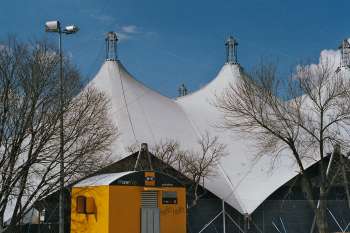Using the "strength through shape" principle, curved forms such as membranes and domes are stronger, more efficient, and more economical than the equivalent rectilinear structures. It is our policy to use this principle wherever possible when designing structures. This organic architecture can  fascinate and inspire, and reflect the harmony of natural forms such a sand dunes or breaking waves.
fascinate and inspire, and reflect the harmony of natural forms such a sand dunes or breaking waves.
The membrane is unique when compared to traditional structures in that it is extraordinarily efficient. All visible components have a structural purpose as well as visual. The double curvature of the surface provides structural stability. Upward curvature accepts downward loads, downward curvature accepts upward loads. Generally, the more curvature the surface has, the more it can accept loads. Large deformation is resisted by prestressing the membrane to a level that is not countered by external forces. Allowance must be made for water runoff and the collection of snow, particularly at valley areas.
Architectural membranes appeal to the designer because of their novelty, their lightness of touch and feel, and their ability to change the space under and around them. They rely on geometric form for their shape, not the designer's whim, which provides a challenge to the designer that other built forms do not. This also means that the designer or architect should work with the engineer at an early stage of the project to ensure the proposal uses a form that can be realised and built. As the surface form can only be (easily) generated in software, the realisation of the membrane shape is less easy than with traditional materials. This requires the structural design of the project to be totally integrated with the architectural concept.
There are no British Standards or building regulation guidance specifically for permanently installed membranes. Guidance on how to lay out the form of the roof is virtually non existent. For example, few permanent structures rely on the membrane as the primary load-bearing element against wind and other loads. In most cases, the designer breaks down the membrane into modules divided by the supporting structure for manufacturing, transport, installation and replacement reasons.